The best and worst ready-to-eat soups at your supermarket

Ready-to-eat soups in a can or pouch are a convenient winter meal. There’s no chopping or whizzing and only a quick heat up in the microwave or on the element. But how healthy are they?
To find out, we checked out the nutritional information of 58 ready-to-eat soups sold in supermarkets. We also spoke to Dr Leanne Young, public health dietitian and member of the Food Policy Expert Group of Health Coalition Aotearoa.
We surveyed chicken, pumpkin and tomato can and pouch ready-to-eat soups. It’s difficult to compare products per serving size because pack sizes differ. So, to make it fair, we compared soups per 250g (about one cup).
Key findings
- 27 of the 58 ready-to-eat soups in our survey provide more than one-third of the recommended daily limit for sodium in a 250g serving.
- 11 of the 58 ready-to-eat soups contain 4g or more (about one teaspoon) of saturated fat in a 250g serving.
- Soup can contribute to your fibre intake. 7 of the 58 ready-to-eat soups in our survey boost fibre intake by 5g or more per 250g serving.
- Serving sizes for the ready-to-eat soups range from 200g to 430g and this needs to be a consideration when comparing nutrition information panels.
Salt content
All the ready-to-eat soups in our survey are ‘souped up’ with salt. It’s the sodium in salt that’s bad for your health.
Young said too much salt (sodium) in the diet can increase blood pressure. This is a leading cause of strokes.
“People who eat a low-sodium diet have a lower risk of high blood pressure, heart disease and stroke. Use the nutrition information on the packaging to compare sodium contents between products and help you find lower salt soups,” she advised.
The Ministry of Health recommends adults eat less than 2,000mg of sodium a day. That’s about 5g of salt (or about 1 teaspoon). However, for good health, you only need 460 to 920mg. Children need even less. Around 75% of the salt we eat comes from packaged or processed foods.
Nearly half the ready-to-eat soups in our survey (27) provided more than one-third of the adult recommended daily limit for sodium in a 250g serving.
Wattie’s Soup for One Creamy Tomato is the worst sodium offender (925mg/250g). It provides more than half the daily recommended limit if you eat the 300g can in a single sitting.
Highest sodium content 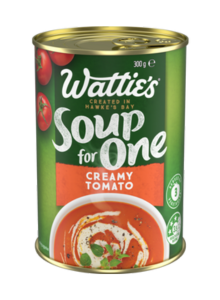
- Wattie’s Soup for One Creamy Tomato – 925mg/250g
- Wattie’s Very Special Creamy Tomato Soup – 900mg/250g
- Hansells All Natural Chicken & Corn Soup – 873mg/250g.
Lowest sodium content
- Only Organic Nourish Wholesome Soup Tomato, Capsicum, Potato & Wild Rice – 325mg/250g
- Only Organic Boost Wholesome Soup Pumpkin, Red Lentils, Coconut & Turmeric – 380mg/250g
- Woolworths Smooth Pumpkin Soup – 420mg/250g
- Pitango Free Range Chicken & Noodle Soup – 453mg/250g.
Saturated fat content
Saturated fats are found in animal fats and palm and coconut oils. In the ready-to-eat soups we surveyed, the products with the highest amounts of saturated fats included cream or coconut milk as an ingredient.
Young said saturated fat raises the levels of ‘bad’ low-density lipoprotein (LDL) cholesterol and total cholesterol in your blood. Saturated fats can also promote blood clotting. This can lead to heart attacks or strokes.
Highest saturated fat content 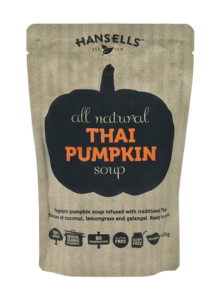
- Hansells All Natural Thai Pumpkin Soup – 11.3g/250g (9g in the single 200g serving).
- Woolworths Creamy & Chunky Chicken Chowder Soup – 9g/250g
- Pitango Organic Pumpkin & Ginger Soup – 7g/250g.
Sugar content
Many ready-to-eat soups have a small amount of added sugar – you’ll see it included in the ingredients list near the bottom. But most of the sugar in soups listed in the nutrition information panel is naturally occurring from the vegetables.
You can’t always work out the proportion of vegetables in a ready-to-eat soup because companies are only required to list the percentage of ‘characterising’ ingredients – for example, the percentage of pumpkin in pumpkin soup.
The chicken ready-to-eat soups in our survey generally had lower amounts of sugar compared with the tomato and pumpkin soups.
Young said soups aren’t a major source of sugar in the diet.
“If you’re trying to reduce your sugar intake, reduce high sugar items like soft drinks.”
Highest sugar content 
- Wattie’s Soup for One Creamy Tomato – 15.3g/250g
- Wattie’s Very Special Tomato & Basil Soup – 15g/250g
- Woolworths Smooth Pumpkin Soup – 13.8g/250g
- The Good Taste Co Creamy Pumpkin Soup – 13.8g/250g.
Fibre content
Soup can also contribute to your fibre intake. 7 out of the 60 ready-to-eat soups in our survey boost fibre intake by 5g or more per 250g serving. It’s recommended women eat 25g and men 30g of fibre each day.
Young said fibre from soup that contains vegetables, beans and lentils is great for gut health.
“Fibre and water help keep everything in your gut moving, which helps prevent constipation. Fibre also helps you feel full for longer,” she says.
Highest fibre content 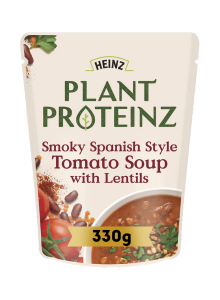
- Wattie’s Plant Proteinz Smoky Spanish Style Tomato Soup with Lentils – 8g/250g
- Strength Meals Co High Protein Soup Spiced Pumpkin & Lentil – 7.8g/250g
- Wattie’s Plant Proteinz Mexican Style Tomato & Black Bean Soup – 7g/250g.
Protein claims
Strength Meals Co make a range of high-protein ready-to-eat soups. The 2 soups we checked from this brand both contain 16.1g protein in a 320g serving. That’s about double the protein per 100g of other soups in our survey that claim to be a source of protein or the equivalent of 2 boiled eggs.
In the chicken and vegetable soup, the main protein boost comes from beef protein powder and chicken. In the spiced pumpkin and lentil soup, the main protein sources are lentils, peas and soy protein isolate.
Wattie’s Plant Proteinz soup also claims its range contains 15g of plant protein per serve. In its Mexican Style Tomato & Black Bean Soup, the main protein sources are black beans and pea protein.
Young said both protein powder and food sources can help meet daily protein needs. However, whole foods generally offer a wider range of nutrients and are considered a better option for most people.
“Most New Zealander’s eat enough protein without any special effort. Requirements can easily be met by consuming whole and less-processed protein foods, including legumes, nuts, seeds, fish and other seafood, eggs, dairy products and meat with the fat removed. These foods provide protein along with other important nutrients, such as iron and zinc, fibre [plant-based foods] and essential fatty acids [fish],” she said.
Young also cautioned against relying on protein claims for other food categories. Protein claims are turning up on ultra-processed products, including chips and ice-cream, and we found many products making protein claims are more hype than health.
What’s the difference between chilled and unchilled ready-to-eat pouch soups?
When it comes to nutrition, there’s not much difference between the soups you find in the chiller and the pouches on supermarket shelves. The ingredients lists are also similar.
But there’s a big difference when it comes to shelf life. Ready-to-eat soups in the chiller generally have a shelf life of 2 months (depending on the flavour) and must be kept refrigerated. Some unchilled pouches can sit on the shelf for up to 2 years.
So why the difference? Manufacturers say the shelf life of ready-to-eat pouch soups is determined by two factors: the packaging and the manufacturing process.
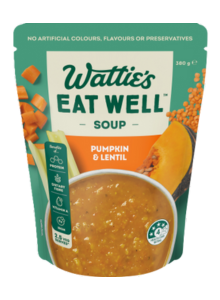
soup packaging.
Unchilled ready-to-eat soups are in opaque packaging. This protects the soup from light, which can make food deteriorate faster. Some brands have an extra foil layer for added protection.
Also, the soup undergoes an additional processing step called retort cooking. This involves heating the soup to a very high temperature (similar to pressure cooking), so the soup will last for a long time.
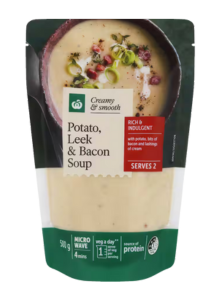
soup packaging.
All the chilled ready-to-eat soups we surveyed were in clear packaging and had probably not undergone the additional processing step. According to the manufacturers of chilled ready-to-eat soups, this makes them more like homemade soup. We’ll leave the taste testing to you!
What about canned soups? Most of the canned soups in our survey didn’t have a best-before date. The Food Standards Code doesn’t require a best-before date if a product has a shelf life of more than 2 years. As long as the container remains intact, canned foods have a long shelf life even at room temperature.
What about dried packet soups?
We didn’t include dried packet soups in our survey. While these are a budget-friendly option, they are full of dehydrated, processed ingredients. That means they aren’t as filling, provide little or no fibre and don’t contain as many nutrients compared with the other soups in our survey.
Top tips for making homemade soup
Young said homemade soup is a relatively low-cost meal and a great way to increase your vegetable intake. Here are her top tips for a good homemade soup.
- Make your own stock from chicken or meat bones or vegetables for a meat-free option. Pre-made stocks are convenient but check the labels and look for low salt/sodium options.
- Add plenty of seasonal, low-cost vegetables like potatoes, carrots and pumpkin. Soup is also a good way to use up vegetables that aren’t as fresh and you are thinking of throwing out.
- Add beans or lentils (canned or dried) to increase the fibre and protein content. Canned products are convenient but choose beans or lentils in water rather than brine to keep the sodium content low.
- Soup stores well in the fridge and freezer, so you can make a big batch and freeze some for later. If you’re short on time, you can throw some vegetables and stock in a slow cooker and leave it to do the work. We’ve tested a range of slow-cooker models to suit all budgets.
Soups compared
Chicken soups
Pumpkin soups
Tomato soups
We've tested 23 benchtop blenders.
Find the right one for you.


.jpg&w=315&q=75)
Member comments
Get access to comment